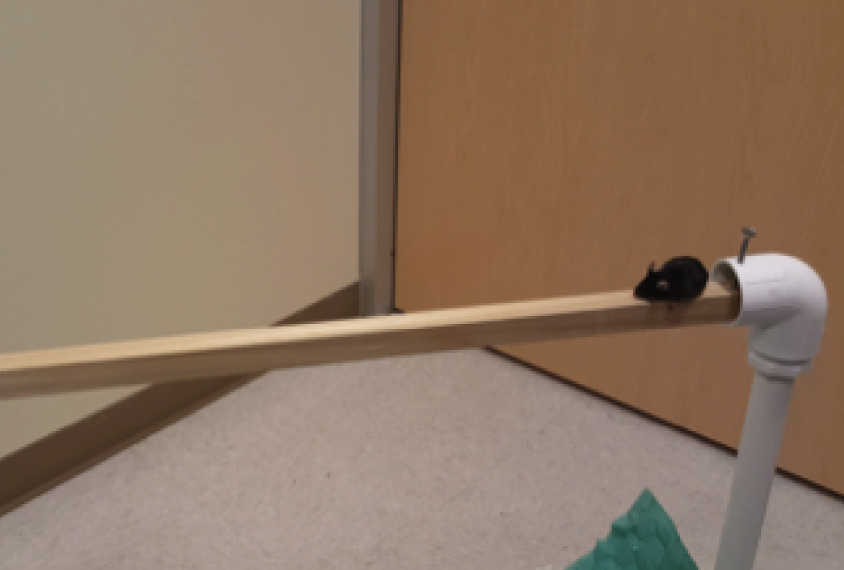
Anxiety, seizures mark mice with extra copy of autism gene
Mice with an extra copy of UBE3A, a gene linked to autism, have learning problems and anxiety, and are prone to seizures and fine-motor problems.
Mice with an extra copy of UBE3A, a gene linked to autism, have learning problems and anxiety, and are prone to seizures and fine-motor problems. Silencing the surplus gene, even as late as adulthood, alleviates the mice’s anxiety, researchers reported last Thursday at the 2017 Dup15q Alliance Scientific Meeting in Los Angeles.
UBE3A dwells in a chromosomal region called 15q11-13. Extra copies of this region result in a condition called dup15q syndrome, which is characterized by movement problems, cognitive impairment, anxiety, seizures and autism.
Mouse studies hint that many of the features of the syndrome can be traced to UBE3A. In November, for example, the same team reported at a conference that mice with an extra copy of UBE3A have cognitive deficits and anxiety. They published these results 19 July in Human Molecular Genetics1.
In the meantime, the team has homed in on the mice’s vulnerability to seizures as well as fine-motor problems.
“The [mouse] phenotypes are highly analogous and clinically relevant,” says lead investigator Jill Silverman, assistant professor of psychiatry and behavioral sciences at the University of California, Davis.
However, the mice do not show social difficulties or repetitive behaviors, two features seen in most people with the syndrome. This suggests that other factors contribute to the syndrome.
Missing features:
UBE3A encodes at least three forms of the corresponding protein. Silverman and her collaborators engineered their mice to produce excess amounts of the longest form.
The mutant mice are less likely than controls to enter brightly lit or open areas of a cage, suggesting that they have heightened anxiety, the team found. The mice also appear to have some learning and memory difficulties: They can learn to associate a tone with a foot shock, but they don’t connect the shock with the sights and smells of the environment in which they first experienced it.
The mice do not appear to have spontaneous seizures. However, some of the mutants die unexpectedly, so Silverman says she is not ready to rule out spontaneous seizures. To confirm, the researchers are using a device to record the animals’ brain waves as they sleep or move about their cages. The researchers have also found that when they inject the mice with a compound that induces seizures, the mutants seize more quickly than controls do — suggesting that the mutants are more vulnerable to seizures.
The team reported in November that the mice do not show any obvious gross-motor problems. However, the mutants take longer and their paws slip more often when traversing a narrow beam, compared with controls. This finding hints at fine-motor deficits in the mutants. “There may be a subtle motor phenotype that we should be investigating further,” Silverman says.
Control switch:
The researchers engineered a molecular switch that allows them to turn off the extra copy of UBE3A by injecting the mice with a drug called doxycycline. They treated four adult mice with the drug for two weeks. These mice no longer seem anxious when entering cages, Silverman says. “That was encouraging to see.”
The team is exploring whether turning off the extra copy reverses other features in the mice.
The researchers have confirmed their findings on social and repetitive behavior in at least two separate batches of the mutant mice. Still, the results are at odds with those from another mouse strain with excess UBE3A, created by Matthew Anderson and his colleagues at Harvard University. Anderson’s mutants are less social than controls and groom themselves obsessively.
It is unclear why the two strains produce discrepant results, but it may have to do with which form of the UBE3A protein the extra copy makes. Anderson’s mice have excess levels of a form of the protein that resides in the cell’s nucleus, whereas the form in Silverman’s mice is found primarily in the cytoplasm. Silverman says the disparities could also be due to differences in the ages and strains of the mice used in the studies.
For more reports from the 2017 Dup15q Alliance Scientific Meeting, please click here.
References:
- Copping N.A. et al. Hum. Mol. Genet. Epub ahead of print (2017) Abstract
Recommended reading

Developmental delay patterns differ with diagnosis; and more

Split gene therapy delivers promise in mice modeling Dravet syndrome

Changes in autism scores across childhood differ between girls and boys
Explore more from The Transmitter

Smell studies often use unnaturally high odor concentrations, analysis reveals

‘Natural Neuroscience: Toward a Systems Neuroscience of Natural Behaviors,’ an excerpt
